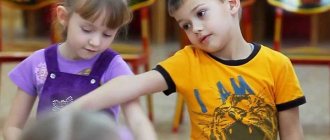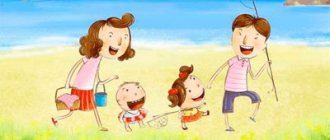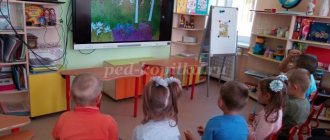Tatiana Ovchinnikova
Card index of didactic games on the topic “My Family”
Card index of didactic games
on the topic "My family "
"Who's in charge?"
Goal: To encourage children to remember and name their family ; bring to the understanding that both children and adults are the most important in the world; cultivate love and respect for your family .
Material: "Family Tree"
; illustrations depicting what mom, dad, grandma, grandpa, and child are doing.
Progress of the game:
The teacher invites the children to take turns naming their family members and saying : who does what, who does what in the family . If it is difficult for a child to say who does what in the family , then illustrations will help him with this. Children say who is the boss in the family and why they think so. At the end of the game, it should be determined that everyone is important in the world - both children and adults.
"What are the names of family "
Goal: To strengthen children's ability to clearly name their family ; develop memory, coherent speech; cultivate love for your family .
Progress of the game:
Children stand in a circle and take turns naming their family . For example: “I live with my mother Natasha, father Sasha, brother Vladik. I have grandmother Lida, grandmother Vera, grandfather Grisha and grandfather Pavel.”
"Little Helpers"
Goal: To bring children to understand that they need to help their loved ones and give them their love; teach children to talk about their help in their family ; develop coherent speech and thinking.
Material: box, bear.
Progress of the game:
to the children ”
.
He “quarreled with his mother”
because
“he didn’t want to put his toys away
. And now he doesn’t know how to make peace with his mother.
Educator. Guys, do you get offended by your family when they scold you? Relatives need to be loved and helped. How do you help your family at home? I have my grandmother’s box, you will put all your help in it, and we will give the box itself to the bear so that he also learns to help his mother and does not forget about it.
Children take turns talking about how they help their mother, father, brother, sister, grandmother, and grandfather at home, and put their stories in a chest. The little bear “thanks”
children for
the “magic box”
and returns to the forest to make peace with his mother and help her.
"Sweet Nothing"
Goal: To promote children’s ability to affectionately and lovingly address their family; develop coherent speech and thinking; cultivate love for your family .
Material: ball.
Intellectual game for schoolchildren in grades 7-8 on the topic: Family
Intellectual game for schoolchildren in grades 5-9 “Linguistic Pentagon” on the theme “FAMILY”
Brief description of the work The game will help raise the prestige of knowledge and promote the intellectual development of the personality of students in grades 5-9 Objectives: 1. Raise the prestige of knowledge 2. Promote the intellectual development of the individual. Objectives: 1. Development of imaginative and logical thinking. 2. Development of variability of thinking, creativity, imagination and constructive skills. 3. Development of speech (the ability to substantiate one’s beliefs, build simple conclusions). 4. Formation of the skills to think and plan actions, implement decisions, guess about the results and check them strictly subject to given rules and algorithms. Equipment : envelopes for teams, mini answer sheets, pens, watch or stopwatch, game report. Rules of the game: Teams of 5 people are created. Each team must be assigned a “runner,” that is, a person who will carry envelopes with answers to the jury table. When the team is ready to give an answer, they write it on a mini-sheet and put it in an envelope, after which the “runner” carries the answer to the jury table. The judges note how many points the answer is given and only when the correct answer is announced by the presenter do they check the team envelopes. The jury must have at least 2 people. One jury member keeps track of time, the second is responsible for assigning points. Round 1 “Family Traditions” maximum 5 points
According to the rules of the game, in the first round the presenter announces the topic of the question and begins to read out the clues.
For one question, the presenter reads out 5 clues. The time to think about the answer for each clue is 1 minute. Each team has the right to give an answer for each clue. The team that gives the correct answer from the first clue receives +5 points, from the second - +4 points, from the third - +3 points, from the fourth - +2 points, from the fifth - +1 point. For any incorrect answer from any clue, the team receives 0 points. The team does not receive additional points for duplicate correct answers. 15 seconds after the announcement of the fifth clue, the correct answer is announced. For one question, a team can earn a maximum of 5 points (if they answer correctly from the first clue and do not give a single wrong answer) and a minimum of 0 points (if they give one wrong answer to all 5 clues). 1. Topic: a polysemantic word 1. A group of animals, birds, consisting of a male, female and cubs, 2. It begins with children, Herzen believed 3. A group of close relatives living together 4. This is a unit of society 5. They say there is a freak in it Answer: Family 2. Topic: a polysemantic word 1. For Orthodox and Catholics who observe church everyday rituals, the day of remembrance of some saint 2. This is a holiday for the person who was named after this saint at baptism 3. Angel's Day 4. It is considered that if you dream of them, then this portends successful establishment of contacts with business partners. 5. On this holiday, it is customary to bake a loaf Answer: name day 3. Topic: ambiguous word 1. The thoracic organ that receives blood from the whole body 2. It lies between two unequal halves of the lungs 3. It is usually offered along with the hand 4. Sometimes it goes to his heels 5. The song says that he doesn’t want peace at all Answer: heart 4. Topic: ambiguous word 1. Plural means trousers, trousers, trousers 2. Legal union of husband and wife 3. Goods that turned out to be unusable, damaged or below proper kindness 4. Marriage 5. Hitchcock said that he will only be happy when the husband understands every word that the wife did not say. Answer: marriage 5. Topic: ambiguous word 1. Rituals accompanying marriage. 2. For many peoples, this includes the ritualized move of the bride from her parents' house to the groom's house, 3. Exchange of gifts, feast 4. They say that she will live to see her 5. Silver - twenty-fifth anniversary of married life Answer: wedding round 2. “Family Values” For the correct answer, a maximum of 25 points.
According to the rules of the game in the second round, the presenter announces the topic of the question and begins to read out the clues.
For one question, the presenter reads out 5 clues. The time to think about the answer for each clue is 1 minute. Each team has the right to give an answer for each clue. The team that gives the correct answer from the first clue receives +25 points, from the second - +20 points, from the third - 15 points, from the fourth - +10 points, from the fifth - +5 points. For any incorrect answer from any clue, the team receives 0 points. The team does not receive additional points for duplicate correct answers. 15 seconds after the announcement of the fifth clue, the correct answer is announced. For one question, a team can earn a maximum of 5 points (if they answer correctly from the first clue and do not give a single wrong answer) and a minimum of 0 points (if they give one wrong answer to all 5 clues). 1. Topic: polysemantic word 1. Synonym of the word Equilibrium 2. Proportional relationship of parts of the whole 3. Correct relationship of simultaneous sounds and the very science with consonances 4. It is an etymologically root word that denotes a musical instrument - movable bellows with two boards equipped with a keyboard 5. In relationship psychology, this is considered the most important principle. Answer: harmony 2. Topic: ambiguous word 1. A feeling of respect, 2. An attitude based on the recognition of someone’s merits 3. Tolstoy believed that a person should feel this towards himself 4. An informal high assessment of an individual’s activities 5. It can be universal , deep, enormous, deserved Answer: respect 3. Topic: ambiguous word 1. A city with this name has existed in Ukraine since 1963 2. The state of a person corresponding to internal satisfaction 3. For a married person it depends on those to whom he is not married , Oscar Wilde believed 4. Chance, a welcome surprise according to Dahl’s dictionary 5. If it weren’t for him, but misfortune would help Answer: happiness 4. Topic: ambiguous word 1. When buying this, first ask who your neighbors are, says Jewish proverb 2. There is an expression that he is my fortress 3. A place of permanent residence of a person 4. An institution dedicated to the memory of a historical person. 5. On the first channel there is a program called “While everyone is there” Answer: house 5. Topic: ambiguous word 1. Deep emotional attraction 2. She will unexpectedly appear when you are not expecting her at all 3. Tolstoy considered this a priceless gift 4. Terry Goodkind said that this is when you share your whole life with another person” 5. They say that all ages are submissive to her Answer: LOVE Round 3. “Family composition” Maximum points 50
According to the rules of the game, in the third round the presenter announces the topic of the question and begins to read out the clues.
For one question, the presenter reads out 5 clues. The time to think about the answer from each clue is 15 seconds. Each team has the right to give an answer for each clue. The team that gives the correct answer from the first clue receives +50 points, from the second - +40 points, from the third - +30 points, from the fourth - +20 points, from the fifth - +10 points. For any incorrect answer from any clue, the team receives 0 points. The team does not receive additional points for duplicate correct answers. 15 seconds after the announcement of the fifth clue, the correct answer is announced. For one question, a team can earn a maximum of 50 points (if they answer correctly from the first clue and do not give a single wrong answer) and a minimum of 0 points (if they give one wrong answer to all 5 clues). 1. Topic: a polysemantic word 1. An ancestor, the founder of something 2. The first, ancient example of something 3. It doesn’t bother me that I’ve already become one, the only bad thing is that I’m married to my grandmother, Groucho Marx said 4. In song, he is always next to his grandmother 5. Father of the father or mother Answer: grandfather 2. Topic: ambiguous word 1. This is a relative who appears as a result of marriage. 2. Perhaps it came from the verb CONSOLE 3. She has a beloved son-in-law. 4. It is believed that her pancakes are the sweetest and most delicious 5. Mother of the wife. Answer: mother-in-law 3. Topic: ambiguous word 1. River in the south of Eastern Siberia 2. Seleucia (Persian) she is a Christian martyr, a virgin who suffered during the persecution of King Shapur II. 3. In the Orthodox Church, November 20 is her day 4. This is the first word, the main word in every destiny 5. Her hands are woven from tenderness, said Hugo Answer: mother 4. Topic: a polysemantic word 1. in the Russian state of the 15-17 centuries. small feudal lords in the military service of princes 2. Boys and (or) girls at an early age. 3. Sons, daughters. 4. They say that they are the flowers of life 5. When you have them, you become parents Answer: children 5. Topic: ambiguous word 1. Persons related by blood 2. A social group consisting of individuals descended from a common ancestor 3. This is a group of people who periodically gather to count themselves and have a tasty meal due to a change in their number 4. If you dreamed that all of them, both near and far, were gathered in your house, then you are expecting an addition to the family 5. Many of us have them crazy. And many of us, in their eyes, are crazy, says Jim Carrey. Answer: relatives Summing up. The jury's word. Winner's reward ceremony.
We recommend watching:
Scenario of a game program for Earth Day for grades 5-7 Intellectual game for grades 5-9 on the topic: Healthy lifestyle Game “Clever and smart girls”, grades 7-8-9 Scenario of an intellectual game “Own game” for schoolchildren with presentation
Similar articles:
Summary of intellectual class hour in 8th grade
Intellectual game for 6th grade
Intellectual game on history, grade 7
Extracurricular activity 7th, 8th grade in mathematics
Extracurricular activity for 6th and 7th grade on the topic of hobbies
Progress of the game:
Q: Helping mom is good. Why?
Q: Arguing with your brother is bad. Why?
That is, questions are asked according to the principle: “something is good - why?”, “something is bad - why?”
"Let's switch"
Goal: To form ideas about family .
Game rule: The game is played by a subgroup. Each child thinks of his own object and says that he (she)
knows how to do. Then there is an exchange of functions between the children who have guessed the object.
Progress of the game:
P1 - morning. In the morning, everyone wakes up, washes their face, and gets ready for work, school, or kindergarten.
P2 - day. During the day, adults work, children study at school, and in kindergarten children walk, study, play and sleep.
P3 - evening. In the evening, the whole family gathers at home , has dinner, children study homework, adults watch TV, and very young children play.
P4 - night. They sleep at night. The night is needed so that adults and children can rest and gain strength for the next day.
Q: Now imagine that at night the whole family wakes up and begins to get ready for work and so on.
«Family»
Goal: Formation in children of concepts about family .
Event Planning
Planning a themed calendar week is very important and should be done well in advance.
ECD on the topic “My Family” in the preparatory group
During such a GCD, children can be given riddles to guess, the answers to which will be various relatives, a house, and so on.
You can also explore works of art with your children. For example, “Cinderella” would be perfect.
You can also include in the GCD the didactic game “Family Responsibilities”, during which children must place cards with images of various actions under photographs of mom, dad and daughter/son, thereby distributing these responsibilities. The guys must comment on every action. As a result, the teacher can make a generalization about the typical distribution of responsibilities.
Modeling "My Family" in the preparatory group"
Modeling GCD can be devoted to making a gift for relatives and sculpting a panel with flowers.
Algorithm of actions:
- prepare the necessary materials (cardboard, plasticine, napkins, stacks);
- explanation by the teacher of the method of implementation;
- reinforce safety precautions when working with plasticine;
- step-by-step modeling;
- summarizing.
For your information! The teacher must demonstrate how to do it correctly step by step. If necessary, help the children/
Construction on the topic “My Family” in the preparatory group.
You need to design using paper. Children can be asked to design people using cylinders and cones made from paper.
The work consists of several stages:
- preliminary preparation (distribution of scissors, paper);
- passing safety procedures;
- finger exercises to prepare children’s hands for working with paper and scissors;
- direct execution of the task, which the teacher guides step by step, moving on to the next one only after completing the previous one;
- summarizing.
It is recommended that the teacher also engage in construction with the children, and not just help them.
If the group has well-developed fine motor skills, you can invite the children to create not only a family of several people, but also include designing a dog in the task.
Children's projects on traffic rules in kindergartens in accordance with the Federal State Educational Standard
Progress of the game:
— Guys, look at these figures. Who do you see?
— How can you call them all in one word ( family )
.
- Name your family .
— A family can be large or small. Each family can contain people of different ages. And children look like their parents or grandparents. Finger gymnastics: “My family ”
This finger is grandpa
This finger is grandma
This finger is daddy
This finger is mommy
This finger is me
That's my whole family
And now, we need to arrange the relatives of the boy (girl)
So:
First - grandfather, after grandfather - dad, before dad - grandmother, after
dad - mom, between mom and dad boy (girl)
. Do the math
how many are there? Tell me, who is behind whom?
"Gather the Family "
Goal: To form children’s ideas about the family and its members , about the friendly relations of relatives. Development of coherent speech in children. Cultivate love and respect for your family.
Material: cards with images of family (father, mother, daughter, son, grandmother, grandfather, cards with images of shoes, clothes.
Planning a theme week
Home and family relationships are fundamental phenomena in the life of every child, so planning a themed week must be approached carefully.
Thematic weeks are mandatory at preschool educational institutions.
Goals and objectives
The main goal of this week in the preparatory group is to develop ideas about the family as a group of people living together and united by family ties.
Tasks set during the thematic week:
- clarify and deepen children’s knowledge about the family circle and relationships;
- promote the development of children's skills in the areas of reasoning, memorization, logic;
- develop the ability to write short narrative stories;
- cultivate feelings of love and respect for the world around you and your relatives.
Baby Must value family relationships
Lexical topic
In the preparatory group, the lexical component is especially important. This is due to the upcoming transition to a new educational level.
The lexical topic this week can be built in the format of a conversation with the children. Each preschooler should tell a little about his relatives. The following points can be brought up for discussion:
- how many people does the child’s family unit consist of?
- what kind of relatives does he have?
- which of them is the youngest and which is the eldest;
- what is the surname, what are the names of its members;
- a small description of each of them (hobby, profession).
For your information! It is important for children to continue playing. You can play several vocabulary games with them. For example, “Say kindly.” The idea is to come up with diminutive synonyms for words, and they should be set on family topics.
Final event
The best final event to end an event such as family week would be a themed holiday.
It is important to make a plan for this action. It must contain:
- opening speech;
- recitation of poetry by children;
- competitions in which everyone participates - both children and their parents;
- presentation of awards.
For your information! As competitions, you can use a fashion show, a costume designer (a parent creates the most creative costume for their child), a music competition, a competition “My family is the happiest” (everyone becomes a living sculpture, symbolizing how happy they are together).
Songs about traffic rules for preschool children: interesting and funny
An alternative could be the “My Family” project. During this project, an impromptu press conference will be held, at which each child will talk about their relatives, show photographs and answer questions. It is recommended to choose the format of this event if many parents cannot come to the final lesson “My Family” in the preparatory group.
The interaction of the theme week with competitions and speech therapy classes is useful
Progress of the game:
Rules: “There is a family album in every house.
Like in a mirror we are reflected in it.
Even if we are not always beautiful -
But these photos are true.
The album is kept in our house,
Family photos are stored in an album.
Option 1: Children are offered pictures depicting children, adults, and elderly people. Make a family . How can you call these people in one word? Who lives in this family ?
Option 2: Do you think the family takes care of each other? It is necessary to identify who owns these items and explain why they decided so.
"Our friendly family "
Goal: Name family , understand and use the generalizing word “ family ”
.
Material: beautifully decorated box; finger theater, cut out to show finger performances.
Progress of the game:
Open a photo album and invite your child to look at a family photo. Ask him a question, pointing in turn to the image of each family : “who is this?”
.
Ask the child what the name of his mother, father, grandmother, grandfather, etc. is. Invite him to tell him what kind of mother he is? (kind, beautiful, good)
.
What kind of dad is (tall, strict, handsome)
.
What grandmother? (old, kind)
.
Place a beautifully decorated box in front of your child and invite him to see what is hidden in it. (Carved heroes of the finger theater)
. Invite your child to play with the heroes of the finger theater.
This finger is grandpa, (bend your thumb)
This finger is grandma, (bend your index finger)
This finger is daddy, (bend your middle finger)
This finger is mommy, (bend your ring finger)
This finger is me, (bend your little finger)
This is my whole family ! (rotate your hands with your fingers apart)
At the end of the game, praise the child, saying that his family is really very friendly.
"My family "
Goal: To form an idea of the family using the example of people , heroes of fairy tales, using their substitutes.
Material: images of people and heroes from fairy tales.
LiveInternetLiveInternet
Tatyana57
all posts by the author
CHILDREN SHOULD KNOW NOUNS: mother, father, grandmother, grandfather, son, daughter, brother, sister, grandson, granddaughter, surname, first name, patronymic, family, aunt, uncle, father, mother, schoolboy, schoolgirl, excellent student, swimming pool, chess , checkers, magazine, book, TV, radio, house, apartment, entrance. ADJECTIVES: big, small, affectionate, senior, junior, adults, beloved, friendly, kind, evil, tall, low, childish, old, young, colorful, soft, hard, comfortable, comfortable, two-, three-, four-room, strong, weak, exemplary, playful, obedient, cheerful, sad, wise, stupid, lazy. VERBS: sits, stands, sleeps, draws, sews, flogs, cooks, irons, repairs, tears, darns, washes, cleans, scatters, tells, cries, laughs, makes friends, quarrels, helps, cares, grumbles, loves, swaddles, cook, visit. CHILDREN SHOULD BE ABLE TO SELECT THE SIGN: Mom (which one?) - affectionate, kind, gentle, caring... Dad (which one?) - brave, strong, strict, cheerful, hardy... Grandmother (which one?) - kind, affectionate, thrifty, neat... Grandfather (which one?) - hardworking, caring, attentive... Family (which one?) - friendly, strong, united, large, large, athletic... FORM POSSESSIVE ADJECTIVES: Scarf (whose?) - mother's, father's, grandfather's, brother's, sister's... Jacket (whose?) - daughter's, mother's, grandmother's... Coat (whose?) - mother's, father's, grandmother's... BE ABLE TO COMPARE WHO IS OLDER/YOUNGER: Dad - son (father is older, and son is younger). Dad - grandfather... Uncle - grandson... Granddaughter - grandmother... UNDERSTAND LOGICAL - GRAMMARICAL CONSTRUCTIONS: Mother's daughter, mother's daughter, mother's daughter. COMPLETE A STORY ABOUT YOUR FAMILY: FAMILY is your relatives living nearby, in your apartment. Who do you live with? How many people do you have in your family? Who is the oldest? Who is the youngest? Who are the children? Who are the adults? What are the names of your parents, grandparents, brothers, sisters? How do you live? What do mom, dad, brother, sister, you do? What do you like to do on your days off? How are you spending the holidays? Who do you like to visit? Why? Do you love your family? For what?
GAME “WHO IS RELATED TO WHO?” Who is a girl to mom? (daughter) Who is mom's boy? (son) Who is the boy for the girl? (brother) Who is mom to dad? (wife) Who is grandpa's girl? (granddaughter) Who is grandma's boy? (grandson) Who is grandma’s mother? (daughter) Who is mom's dad? (husband) Who is grandma's dad? (son) GAME “WHO IS OLDER (JUNGER)?” Who is older, the girl or the mother? Who is younger, boy or mother? Who is older, the girl or the grandfather? Who is younger, the boy or the grandmother? Who is older, mother or grandmother? GAME “Whose? WHOSE? WHOSE? WHOSE?" Grandmother wears a robe. Whose robe? (grandmother's) Dad wears a tie. Whose tie? (dad's) Mom has a scarf. Whose scarf? (mother's) Petya has a ball. Whose ball is it? (Petin) Grandfather wears a shirt. Whose shirt is it? (grandfather's) Mom wears a hat. Whose hat is it? (mother's) Tanya is wearing a dress. Whose dress? (Tanino) Dad put on his coat. Whose coat? (dad's) Grandfather put on his shoes. Whose boots? (grandfather's) Mom put on her boots. Whose boots? (mother's)
Progress of the game:
The image of the heroes is put on the middle and index fingers using holes. Children can dramatize different stories with these characters. These could also be fairy tales. While playing, children learn to build dialogues, answer questions, etc.
"What are we doing?"
Goal: Formation in children of concepts about family .
Material: cards with relatives and objects.
2-4 people play.
Large cards with relatives are distributed between players, 2 pieces each. small cards with objects are shuffled and laid out face down . Players take turns taking 1 small card and say what the relative with whom he has card “Grandma will play hockey with me today!”
.
If this has never happened in your life, the card is returned to the pile; if it has happened, it is placed on a card with a picture of a grandmother. the next player takes a small , etc. d. during the second round of the game, players place a small card on the second large card . The game ends if there are no more small cards or one of the players has 3 small cards on one large card .
He is the winner! "Kinship"
Goal: Continue to form children’s understanding of close relatives and family .
Material: cards
The presenter takes turns asking the players questions, for example: “Who is the granddaughter?”
, if the one who must answer gives the wrong answer, the next player answers, the one who answered correctly receives a small
card . The game ends when one of the players has 6 cards .
He's a winner. "I and my family "
Goal: Continue to form children’s ideas about family , understand the role of adults and children in the family . Make the child happy and proud that he has a family .
Material: pictures depicting children, adults, elderly people.
Assignments on the topic “Family”
Task 1. “Tender name.” Ball game. The adult throws the ball to the child, naming the family members, the child throws it back, naming the affectionate form. For example: mom-mom, son-son.
Task 2. “One is many.” As in the previous game, you can use the ball. An adult names a family member in the singular, a child – in the plural. For example: mother - mothers, aunt - aunts.
Task 3. “Guess who we’re talking about.” The adult asks questions, the children must answer them correctly. Who has a gentle look? (Mom) Who has strong hands? (At dad's) Who is the most restless? (Brother) Who has the kindest eyes? (At grandma's) Who is the most serious? (Dad) Who is the most obedient? (Sister) Who has wise speech? (Grandfather's)
Task 4. “Our grandmother is tired.” The adult asks you to repeat the actions after him. Before performing, children stand in a circle. Our grandmother was tired, (the children lean forward, clasping their hands behind their backs) She sat down on the threshold: (they squat down) “Where did the grandson go, where did he go.” (they put their hands on their head and shake it) She thought and sobbed, (they put the index finger to her temple, they tilt her head) Then she quietly stood up, (they stand up and straighten up) She walked around the bush - (they walk one after another, holding their hands behind their back) Look for the granddaughter at first. (turn in different directions)
Task 5. “Say otherwise.” An adult shows pictures to children of a family representative and says that he sees: “Mom has blond hair.” Children need to be told in a different way: “Mom is blonde.” Brother has blue eyes - brother is blue-eyed. The sister has pink cheeks - the sister is rosy-cheeked. Dad has brown eyes - dad is brown-eyed. Grandfather has gray hair - grandfather is gray-haired. Granny has dark hair - grandma has dark hair. Exercise
6. “Family locomotive.” The child is given two sheets: one with a picture of a steam locomotive, the second with family members (you can use a photograph), as well as scissors and glue. The task is to paste faces into each carriage according to seniority. For example, grandparents will be the drivers of the locomotive, and mom and dad will be in the first carriage, etc.
If several children complete a task, then upon completion, the works are compared and discussed (since they may turn out different).
Task 7. “Who is behind whom.” Story game. The adult describes the situation. “One day, a family of 6 people: mother, father, son, daughter, grandmother, grandfather, went on a hike. Who followed whom along the path?” “They had to get over a windfall. A number of them fell apart. And when they stood in a column again, their row became completely different. Who walks on the path in front of whom?” Next, children can be given the opportunity to come up with a story themselves, changing the characters several times. You can use different prepositions, for example, who is between whom, who is behind everyone, etc.
Task 8. “Where are whose things?” Children are given a card with pictures of family members and various things. The task is formulated: show with an arrow who owns the things.
Next comes the discussion. An adult asks: “Whose tie?” The child must answer: “Daddy.”
Task 9. “Share the responsibilities.” The game is played for 2 or more children. Props: pictures with family members and tools.
Rules: • Cards are distributed with family representatives. One child - one hero. • Children take turns choosing pictures depicting a tool and giving an explanation for their choice. And also, they answer the question: who else can do the same thing? The one who can accurately complete the task and correctly explain the choice wins.
Task 10. Conversation based on the picture “Lunch together.” Children answer questions.
Who is in the picture? What common word unites them? What does each of the characters in the image do? How does each family member feel?
Task 11. Story based on the picture “Cozy evening”. Children describe the image. In case of difficulty, you need to help them with guiding questions. After the story, discuss with your child why the picture has such a name.
Task 12. “My family” . After completing the tasks, you can invite the child to draw his family.
Progress of the game:
Option 1: Children are offered pictures depicting children, adults, and elderly people. Make a family . How can you call these people in one word? Who lives in this family ?
Option 2: Do you think the family takes care of each other? It is necessary to identify who owns these items and explain why they decided so.
"Lotto"
Goal: Continue to introduce children to household responsibilities, help children feel like part of the family , and consolidate the names of their closest relatives.
Material: playing field, pictures with objects .
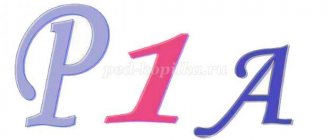
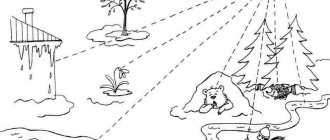
![Letter L and sound [l]](https://pleshakof.ru/wp-content/uploads/bukva-l-i-zvuk-l-330x140.jpg)
